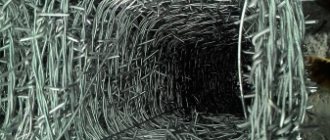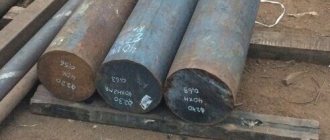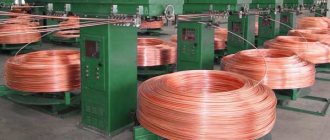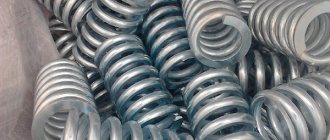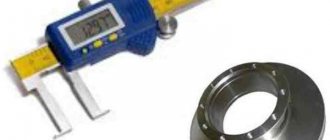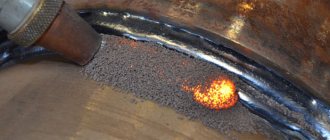1888 America. Engineer Edward Weston was faced with the question of increasing the accuracy of temperature measurement. The operating principle of thermocouples was based on the thermoelectric effect. Two connected conductors have a contact potential difference between them. If the temperature at the ends of the conductors is the same, then the potential difference is zero. If not, then the potential difference depends on the temperature difference at the ends. The difficulty was that when heated, the conductor changed its electrical conductivity, thereby increasing the measurement error. Constantan is an alloy that solved this problem.
Weston's long experiments with copper alloys were not in vain. The new material was distinguished by its resistance stability when the conductor was heated. The inventor gave it a rather laconic name “alloy No. 2”. Later, German wire manufacturers renamed it constantan, which means “constant” in Latin.
So what does a constant include? Why do its prices continue to rise?
Properties, characteristics of constantan tape
The semi-finished product for the manufacture of constantan tape is supplied in a solid state, which is determined by the properties of the alloy, processed by pressure, or is subjected to annealing - an additional “softening” heat treatment at high temperatures.
Constantan tape, supplied in a soft state, has a strength from 390 to 590 MPa, in a hard state - over 640 MPa. Constantan was discovered in 1888 by Edward Weston, who was an American inventor. He used the resulting alloy in coils of electrical measuring equipment, the resistance of which does not depend on temperature changes. The designer assigned the name “Alloy No. 2” to the material, but German manufacturers, who were the first to fulfill the order for the production of products from the resulting alloy, assigned it the name “Constantan”, which remains to this day.
The cost of constantan tape MNMts40-1.5 is influenced by the quality of its production, manufacturing and processing method, size and weight of the product. In addition, the cost is affected by the volume of sales. Even with a small wholesale, the price is lower than in retail sales.
The characteristics of the product are determined by the properties of constantan. The most popular product brand is MNMts40-1.5. This alloy, silver in color with a yellowish tint, contains copper in an amount of 56.2% or more by weight, 39-41% nickel with cobalt, 1-2% Mn manganese. A small amount of impurities is allowed. A particularly important property of constantan tape is its high electrical resistivity, equal to 0.45-0.52 μOhm*m, which does not change when heated to 400-500°C
Particular attention should be paid to the high thermoelectromotive force (TEMF) of constantan, which, together with some elements (copper, iron, chromel - an alloy of chromium-nickel), is used for the production of thermocouples
The most important practical advantage of this material is its constant resistivity, regardless of temperature conditions, which is why the material is called constantan. At a temperature of 20°C, the electrical resistance is 0.48 μOhm*mm2/m
Constantan tape is characterized by good processability. Due to the high ductility of MNMts40-1.5, it is possible to produce thin foil with a micron-sized cross-section. Tape MNMts40-1.5 can be easily stamped, soldered, and welded.
Constantan tape of hard and soft state is supplied in cuts and rolls. Semi-finished products are produced with the following dimensional parameters:
- width 10 - 300 mm;
- thickness from 0.1 to 2 mm.
With a tape thickness of 0.1 to 0.18 mm, its width is no more than 170 mm. Quality control of semi-finished products is carried out at all stages of the technological process. The surface of the constantan tape is controlled by the relevant GOST(s), preventing mechanical damage, delamination, and tears. The tape is supplied with standard, high-precision tape.
Advantages of constantan tape:
- high electrical resistance;
- low temperature coefficient of electrical resistance;
- high thermal power when assisted by certain elements and alloys;
- excellent technological properties.
Flaws:
- The melting point is quite low;
- quite high cost due to the content of expensive, scarce nickel;
- Constantan tape cannot be used at elevated temperatures in sulfur-containing environments (nickel present in the composition will be destroyed).
The technological rolling operation used to produce constantan strip is one of the most common metal processing carried out to produce cold-rolled products without heating the workpieces.
Standards
The high quality of the product is ensured by the following standards:
- Those. the conditions of constantan tape are regulated by GOST-5189-75.
- The accuracy of manufacturing and processing of constantan products is controlled by GOST-26877-2008.
- The quality of the primary elements of copper and nickel is controlled by GOST (ohm)-859-2001 and GOST (ohm)-849-2008, respectively.
- The chemical composition of constantan is regulated by GOST-492-2006.
According to the above regulatory documents, the surface of the constantan tape must be clean, smooth, without delamination, cracks, cavities, foreign inclusions, and other significant defects that affect the performance characteristics.
Alloy Application
T5k10 alloy decoding and application
Manganin has found wide application in electronics. It is used to create high-precision resistors, bridge circuits and shunts. Due to its high resistivity, the material is used in the manufacture of components for electrical measuring instruments: galvanometers, ammeters, voltmeters and wattmeters. It allows the device to more accurately record changes in electric current.
Manganin wire
Manganin is also used in the manufacture of wire mechanisms. Using this metal, it is possible to produce wires and metal strips of various lengths and thicknesses. It is used in the production of winding wires with natural silk insulation and coated with special enamel. Depending on the chemical composition of the raw material, the properties of the wires change. In the presence of aluminum impurities, mechanical characteristics are improved, which makes it possible to use wire mechanisms in the cable industry. Hard manganin, which has great strength, is used for making frames and outer shells, while soft manganin is used for internal filling.
Due to its electrical properties, the alloy is used in the production of precision resistors, which are the main components of electrometers. The manufactured devices have a stable resistivity coefficient, which avoids the occurrence of thermoelectric currents.
What is it measured in?
According to the international system of units, the value is measured in ohms multiplied by a meter. In some cases, the unit used is ohm multiplied by millimeter squared divided by meter. This is a designation for a conductor having a meter length and a square millimeter cross-sectional area.
Unit
History of creation
Ceramic capacitor, composition, types, properties and applications
Constantan was first obtained in 1888 by American inventor Edward Weston. He used this alloy as a material for the coils of electrical measuring instruments, the resistance of which does not depend on temperature. The inventor called it “Alloy No. 2,” but the German manufacturers with whom he placed an order for the production of wire from the new material gave it its own name, “Constantan,” by which it is currently known.
Properties:
– has a soft yellow-silver color,
– melting temperature +1260 °C,
– density 8,800-8,900 kg/m3,
– high specific electrical resistance, which is 0.45-0.52 μOhm*m,
– lends itself well to machining, as well as welding and soldering,
– easily deformed,
– high degree of plasticity,
– hardness 155 HB and 75-90 HB (after annealing),
– low temperature coefficient of electrical resistance, ranging from -0.02·10-3 to +0.06·10-3 °С-1. The alloy practically does not change its electrical resistance with temperature changes,
– not magnetic,
– develops high thermoelectromotive force (thermo-EMF) when paired with certain metals (for example, copper and iron) and alloys (for example, chromel). Heating of alloy contacts in a closed circuit consisting of series-connected constantan conductors paired with the indicated metals and alloys leads to the appearance of an electric current in it,
– temperature coefficient of linear expansion in the range of 20-100 °C, which is 14.4·10-6 °C-1,
– high corrosion resistance,
– after heat treatment, the surface of the alloy is covered with a durable oxide film with excellent electrical insulating characteristics.
Site Map
density specific electrical resistance of constantan in ohm m metal wire manganin thermocouple copper nichrome iron constantan alloy wire conductor buy properties scrap price application composition and application
comments powered by HyperComments
What does it depend on
Resistance depends on temperature. It increases when the thermometer rises. This is explained by physicists in such a way that as the temperature increases, atomic vibrations in the crystalline conductor lattice increase. This prevents free electrons from moving around.
Note! As for semiconductors and dielectrics, the value decreases due to the fact that the structure of the concentration of charging carriers increases.
Temperature dependence as the main property of conductive resistance
Application
Anaerobic sealants: properties and application
Constantan wire is used to make conductors between the receiver and the contactor of high-precision temperature meters. It is also used to make thermocouple compensation wires. Wire and tapes are used to create resistive, tape and wire heating elements for industrial furnaces for smelting metals with a low melting point. Finally, rheostats, resistors, and strain gauges are produced from constantan.
Firstly, high electrical resistance contributes to rapid and intense heating. Secondly, the low temperature coefficient of resistance makes it possible to significantly simplify the design of the heater. Thus, it eliminates the need to step down the voltage at start-up, hence no transformer is required. Thirdly, good technological features make it possible to create parts with complex configurations.
Thus, thanks to the above-mentioned properties of constantan in total, it is possible to manufacture short heating elements with a large cross-sectional area from it. This is considered a significant advantage for the following reasons. First, many types of ovens, such as laboratory ovens, are designed for short heating elements. Secondly, large-diameter parts are characterized by a long service life.
Constantan is used for both open and closed heaters. In the first case, it is used in the form of tape and thick wire. This is explained by the combustion of thin wire in the open air at high temperatures (more than 400-450 °C). However, the material in this form is relevant for furnaces with inert gas, vacuum furnaces, and closed heaters. In the latter case, in devices such as heating elements, aimed at heating liquids, air, floors, etc., constantan does not come into contact with the environment. In most of these heaters, it is placed in the form of a spiral of thread in a sealed tube. For high-power models, thick wire and tape are used.
Also regarding the shape of constantan, it should be noted that wire is considered more preferable in terms of technical and economic features for heating equipment in comparison with tape. Thus, for large industrial furnaces, material with a diameter of 3-7 mm is used, for smaller analogues - 0.03-2.5 mm wire. The advantages of wire over tape include lower cost and ease of manufacturing heating elements. Thus, spiral parts are created by machine winding. In addition, the wire spiral, due to its compactness and high ductility, can be placed in equipment in various ways: on arches and walls in zigzags and labyrinths, hung on ceramic insulators, wound on a tubular base. The second method is used in low-temperature furnaces, and the third is considered the most effective. Due to the high labor intensity and cost of creating heating elements from tape, it is usually used mainly in specific cases. In any case, constantan heating elements are similar in terms of efficiency parameters, regardless of shape.
The essence of the phenomenon
This is a value characteristic of a conductor having a length of 1 meter and a cross-sectional area of 1 square meter/millimeter. It is denoted by the Greek letter ρ. Different materials have different resistivities. At the same time, the resistance of the conductor will change in direct proportion to the length and in inverse proportion to the cross-sectional area. That is, the longer the conductor, the higher it is, but the greater the thickness, the lower it is.
Length
Previous
MiscellaneousWhat is the difference between an RCD and a difavtomat?
Production
For the production of constantan wire, the pressure method is used by drawing. This operation is performed in a cold manner without heating the workpieces, resulting in cold-drawn metal products.
Hard state constantan wire is produced up to 0.09 mm in diameter, and with a cross-section greater than 0.09 mm - in hard and soft states. Soft - obtained as a result of annealing.
The dimensional parameters of constantan wire, delivery, mechanical properties, as well as electrical resistance are regulated by GOST (ohm)-5307-77.
The main requirements for quality indicators include ensuring a clean, smooth surface, without delamination and cracks. Partial surface deformations are allowed, with dimensions not exceeding maximum deviations after final cleaning. Also, oxidized areas and tarnished colors should not be allowed on the surface of soft metal products. At the customer's request, it is possible to produce soft products with a larger cross-section than 0.5 mm, which are intended for subsequent drawing, with a light surface.
The resistivity of the material at a temperature of 20 - 25 ° C must correspond to the following permissible values:
- Soft - 0.465 ±0.015 μOhm*m
- Solid - 0.490 ±0.030 μOhm*m
Constantan wire produced in small diameters is in practice called constantan thread or constantan wire of micron diameters.
Formula how to find
According to the provision from any textbook on electrodynamics, the resistivity of the conductor material formula is equal to the proportion of the total resistance of the conductor per cross-sectional area, divided by the conductor length. It is important to understand that the final indicator will be influenced by temperature and the degree of material purity. For example, if you add a little manganese to copper, the overall indicator will be increased several times.
Main calculation formula
Interestingly, there is a formula for inhomogeneous isotropic material. To do this, you need to know the electric field strength with the electric current density. To find it, you need to divide the first quantity by the other. In this case, the result is not a constant, but a scalar quantity.
Ohm's law in differential form
There is another, more difficult to understand formula for an inhomogeneous anisotropic material. Depends on the tensor coordinate.
It is important to note that the relationship between resistance and conductivity is also expressed by formulas. There are rules for finding isotropic and anisotropic materials through tensor components. They are shown in the diagram below.
Relationship with conductivity expressed in physical relations
Constantan and its features
Constantan is a copper-based alloy (58-60%) with a high nickel content (32-40%) and a small proportion of the alloying component - manganese (1-2%). It melts at a temperature of 1260 ᵒC. The density of constantan is 8.9 g/cm3.
It received its name due to its constant ohmic resistance, the value of which remains unchanged even when exposed to significant temperatures. For example, if you measure this parameter at a temperature of 20 ᵒC (its value is 0.48 μΩ×m), and then carry out stabilizing annealing of the constantan, the data will remain unchanged. The temperature coefficient of ohmic resistance will increase, but not the ohmic resistance itself.
Constantan is a hard alloy, the hardness of which is 650-720 MPa, but after stabilizing annealing, its value decreases to 400-500 MPa. The disadvantage of this material is its low thermal emf, which is in the range from 40 to 50 μV/ᵒС. When heated, stray currents appear on the surface of the constantan, especially when in contact with copper, which distort the readings, which is unacceptable in high-precision instruments. Because of this disadvantage, the scope of application of this alloy is limited. In high-precision instrument making, manganin is preferred.
Application area of constantan
Most often, constantan is represented by wire, the diameter of which is represented by a number of standard values in the range from 0.03 mm to 5 mm, and tape, the thickness of which exceeds 0.1 mm. Constantan is rarely used in combination with copper, which is explained by its disadvantage - low thermal emf. The alloy is used in processes whose operating temperature does not exceed 500 ᵒC. Constantan, as a negative electrode, is used in conjunction with iron, copper and chromel, from which positive electrodes are made. Compensation wires, heating devices, and rheostats are made from this alloy.
TEST METHODS
.1a. For tensile and bending tests, determination of electrical resistivity and chemical composition, one sample is cut from each selected roll.
(Introduced
additionally, Amendment No. 2 ).
.1. Sampling for tensile testing is carried out in accordance with GOST 24047-80.
Tensile testing of tapes with a thickness of less than 0.5 mm is carried out on specimens of type I or II with b
= 12.5 mm and
l
= 4
b
according to GOST 11701-84.
Tensile testing of tapes with a thickness of 0.5 mm or more is carried out according to GOST 11701-84 on samples of type I or II with b
= 20 mm and
l
= 11.3
(Changed edition, Amendment No. 2, 3).
4.2. The bending test is carried out according to GOST 14019-80.
The bending test for solid tapes with a thickness of 1 mm or more is carried out around a mandrel with a radius equal to the thickness of the tape.
4.3. Determination of electrical resistivity is carried out according to GOST 7229-76 using the double bridge method with an accuracy of up to 1% of the determined value. For this test, special samples are cut out with a width of no more than 100 mm and a length of at least 500 mm.
4.2 — 4.3. (Changed edition, Amendment No. 2).
4.4. Control of the appearance and size of the tapes is carried out with a specified probability of 96% (acceptance level of defects AQL - 4%).
(Changed edition, Amendment No. 4).
4.4a. The appearance of the tapes is checked by inspection without the use of magnifying devices.
(Introduced
additionally, Amendment No. 4 ).
4.5. The thickness of the tape is measured with a micrometer according to GOST 6507-90 or with a lever micrometer according to GOST 4381-87.
The thickness of the tape is measured at a distance of at least 100 mm from the end and at least 10 mm from the edge. For tapes with a width of 20 mm or less, the measurement is taken in the middle.
The thickness of the tape is measured on each selected roll at points located evenly and randomly along the length of the roll.
Tape length ( L
), mm, calculated using the formula
where D
and
d
are the outer and inner diameters of the roll, respectively, measured with a ruler according to GOST 427-75, mm;
b
— tape thickness, mm.
The results of measuring the thickness of the tape do not meet the requirements given in table. , should not differ from the permissible values by more than half the maximum deviation.
It is allowed at the manufacturing plant to control the thickness of the tape during the production process by other means of measurement that provide the necessary accuracy.
The width of the tape is measured with a caliper according to GOST 166-89.
It is possible to control the width by other means of measurement that provide the necessary accuracy.
The measurement is carried out in one place at a distance of at least 100 mm from the end of the tape.
(Changed edition, Amendment No. 4).
4.6. Selection and preparation of samples to determine the chemical composition is carried out in accordance with GOST 24231-80. The chemical composition of the alloy is determined according to GOST 6689.1-92 - GOST 6689.22-92.
The manufacturing plant is allowed to take samples from the liquid metal of each heat.
(Changed edition, Amendment No. 1, 2).
4.7. The waviness of the edge of the tape is checked by bending it around a mandrel with a diameter of 100 - 120 mm. If the waviness does not disappear, the roll of tape is rejected.
(Introduced
additionally, Amendment No. 4 ).
Parameters and features
This name is an alloy of copper-nickel composition, characterized by thermal stability, electrical resistance, workability, and is used in the electrical industry.
The latter ensures resistance stability at different temperatures. Due to its resistance parameters, constantan is called a resistive alloy. In addition, this material is characterized by a significant thermoelectromotive force. Finally, constantan has good technological properties, which make it machinable by mechanical methods. So, soldering, embossing, stamping, forging, etc. are applicable to it. After annealing, cutting can be used. Zinc contamination makes processing significantly more difficult.
The following are other characteristics of constantan. Its density is 8.8–8.9 g/cm3. Thus, it is the densest nickel alloy, surpassing steel in this parameter. This feature, which determines the large mass of constantan, is due to the significant proportion of copper in its composition. The melting point is 1260 °C, due to which the alloy is thermally stable, maintaining its internal structure up to the specified temperature. Hardness is 155 HB, tensile strength is 400 MPa. The thermal coefficient of linear expansion is 14.4×10-6 in the range from 20 to 100 °C. The heat capacity is 0.0977 cal/g×C, thermal conductivity is 0.05 cal/cm×s×C. There are no magnetic properties. Constantan is characterized by high ductility. Thus, the elastic modulus is 16600 kgf/mm2, the relative elongation reaches 30%, and the contraction is 71%. It should be noted that ductility is significantly reduced when constantan is contaminated with zinc. Due to its high endurance limit of 243 MPa for hot-woven rods (equivalent to steel 45), constantan is suitable for variable load conditions. The copper-nickel composition ensures the alloy's resistance to corrosion. Thus, it does not react with oxygen up to 800 °C, as well as with organic acids and salt solutions. Color – yellowish.
Due to its low strength, constantan is often subjected to additional processing. After annealing, the tensile strength increases to 700-800 MPa, which equates the alloy in this indicator to steel 45. To further strengthen the material in question, cold hardening is used, which involves surface rolling with steel rollers, causing plastic deformation. As a result of this treatment, constantan acquires a tensile strength of 850 MPa and a hardness of 75-90 HB. However, it must be taken into account that both mechanical and thermal treatment of constantan MNMts 40-1.5 reduces ductility: relative elongation is reduced to 4%, contraction - to 21%.
This coating is formed as a result of calcination, therefore products designed for use in electrical equipment are subjected to this treatment during production.
The cost of constantan is formed primarily under the influence of the price of Ni. For example, the cost of the material in question in October 2017 averaged 5 thousand rubles per 1 kg. It largely depends on the shape and its features. So, tape is a little more expensive compared to wire. And for wire, thickness matters: options with a larger diameter are cheaper. For example, as of December 2016, a ton of 0.6 mm wire cost about 2.3 million, and material with a diameter of 1.2 mm - 0.8-1 million. Moreover, as can be seen from the data given, with mass sales the price is significantly reduced. The purchase price is also determined by several factors. Firstly, the condition of the scrap is of great importance, determined primarily by the presence of traces of corrosion. Secondly, the diameter matters for the wire. Thin materials are more valuable.
Thirdly, the volume of supplies is important. Scrap collection points prefer to accept large quantities (more than 100 kg) due to accelerated sales. In such cases, they mark up scrap by 10–15%.
Constantan wire
The most commonly used wire is constantan wire. It is produced in accordance with the requirements specified in GOST 5307-77. Constantan wire of the MNMts 40-1.5 brand is represented by standard diameter values, which range from 0.02 to 5 mm.
TKKh thermocouples are produced from constantan wire, in which it is used as a thermoelectrode element. This alloy acts as a negative electrode. The range of measured temperatures varies depending on what material the constantan is in contact with. So:
- chromel-constantan – from -40 to 900 ᵒС;
- copper-constantan – from -250 to 300 ᵒС;
- iron-constantan – up to -190 ᵒС (for measuring sub-zero temperatures).
As for the mechanical properties of constantan wire, they depend on the state of the alloy. If it is hard, then the diameter of the rolled metal can vary from 0.02 to 5 mm, while the hardness is 650-720 MPa and the relative elongation reaches 15%, and if it is soft, the values are as follows: from 0.1 to 5 mm, 450- 650 MPa and 20% respectively. In this case, the constantan wire retains the ohmic resistance value, regardless of the state of the alloy. To be more precise, in soft it is 0.465±0.015 μOhm×m, and in hard it is 0.049±0.03 μOhm×m.
Constantan wire is used to produce heating elements with an operating temperature in the range from 400 to 500 ᵒC, as well as devices of a low accuracy class, which is explained by the insignificant thermo-emf of the alloy, which remains stable when heated to this limit.
The Metatorg company offers its customers high-quality constantan wire at a good price, both wholesale and retail. Working with us is profitable, and you will certainly be convinced of this by contacting our specialists.
Constantan wire Mnmts 40-1.5 GOST 5307
Constantan wire Mnmts 40-1.5 GOST 5307
Constantan wire Mnmts 40-1.5 GOST 5307
What is the resistance of copper wire
In metals, a current is formed when an electric field appears. It “forces” electrons to move in an orderly manner, in one direction. Electrons from the distant orbits of an atom, weakly held by the nucleus, form a current.
Copper wires
As negative particles pass through the crystal lattice of copper molecules, they collide with atoms and other electrons. There is an obstacle or resistance to the directional movement of particles.
To evaluate the resistance to current, the value of “electrical resistance” or “electrical impedance” was introduced. It is designated by the letter “R” or “r”. Resistance is calculated using Georg Ohm's formula: R=, where U is the potential difference or voltage acting on a section of the circuit, I is the current strength.
Concept of resistance
Important! The higher the impedance value of a metal, the less current passes through it, and it is copper conductors that are so widespread in electrical engineering due to this property.
Based on Ohm's formula, the magnitude of the current is affected by the applied voltage at a constant R. But the resistance of copper wires varies depending on their physical characteristics and operating conditions.
Pricing
The cost of constantan consists of the price of nickel and copper on world non-ferrous metals exchanges. Most Russian industrialists take the London Stock Exchange quotes as a basis. Let us immediately note that the price of nickel is fundamental when calculating the cost of the alloy.
When selling scrap, the price may vary. Its value is influenced by the following factors:
- The presence of traces of corrosion on the surface of the alloy.
- Volume of supplies. It is more profitable for scrap metal collection points to deal with large quantities of 100 kg or more due to the reduction in time for scrap sales. The markup is on average 10-15% of the main cost.
- The price of the wire also depends on its diameter. As a rule, the thinner the wire, the more expensive it is.
Rating: /5 — votes
Comparison of conductivity of different types of steel
The characteristics of steel depend on its composition and temperature:
- For carbon alloys, the resistance is quite low: it is 0.13-0.2 μOhm/m. The higher the temperature, the greater the value;
- Low-alloy alloys have a higher resistance - 0.2-0.43 μOhm/m;
- High-alloy steels have high resistance - 0.3-0.86 μOhm/m;
- Due to the high chromium content, the resistance of chromium stainless alloys is 0.5-0.6 μOhm/m;
- Chromium-nickel austenitic steels are stainless and, thanks to nickel, have a high resistance of 0.7-0.9 μOhm/m.
Copper ranks second in terms of electrical conductivity: it perfectly passes electric current and is widely used in the manufacture of wires. Aluminum is also used no less often: it is weaker than copper, but cheaper and lighter.
Electrical conductivity
So far, we have considered the resistance of a conductor as the obstacle that the conductor provides to the electric current. But still, current flows through the conductor. Therefore, in addition to resistance (obstacle), the conductor also has the ability to conduct electric current, that is, conductivity.
The more resistance a conductor has, the less conductivity it has, the worse it conducts electric current, and, conversely, the lower the resistance of a conductor, the more conductivity it has, the easier it is for current to pass through the conductor. Therefore, the resistance and conductivity of a conductor are reciprocal quantities.
From mathematics we know that the reciprocal of 5 is 1/5 and, conversely, the reciprocal of 1/7 is 7. Therefore, if the resistance of a conductor is denoted by the letter r, then the conductivity is defined as 1/r. Conductivity is usually symbolized by the letter g.
Electrical conductivity is measured in (1/Ohm) or in siemens.
Example 8. The conductor resistance is 20 ohms. Determine its conductivity.
If r = 20 Ohm, then
Example 9. The conductivity of the conductor is 0.1 (1/Ohm). Determine its resistance
If g = 0.1 (1/Ohm), then r = 1 / 0.1 = 10 (Ohm)
Why resistance occurs
Electrons, colliding with charged atoms (ions) that make up the crystal lattice of the conductor, lose speed. The mass of an atom significantly exceeds the mass of an electron, so their collision leads to a loss of speed (“braking”) and a change in the direction of motion of the electron. This creates resistance to the flow (increase) of current. This means that resistance is a physical quantity.
Collisions of electrons with atoms.
Conductor resistivity table
| Silver Copper Gold Brass Aluminum Sodium Iridium Tungsten Zinc Molybdenum Nickel Bronze Iron Steel Tin Lead Nickelin (an alloy of copper, nickel and zinc) Manganin (an alloy of copper, nickel and manganese) Constantan (an alloy of copper, nickel and aluminum) Titanium Mercury Nichrome (an alloy of nickel, chromium, iron and manganese) Fechral Bismuth Chromal | 0,015 0,0175 0,023 0,025. 0,108 0,028 0,047 0,0474 0,05 0,054 0,059 0,087 0,095. 0,1 0,1 0,103. 0,137 0,12 0,22 0,42 0,43. 0,51 0,5 0,6 0,94 1,05. 1,4 1,15. 1,35 1,2 1,3. 1,5 |
The table shows that an iron wire with a length of 1 m and a cross-section of 1 mm 2 has a resistance of 0.13 Ohm. To get 1 Ohm of resistance you need to take 7.7 m of such wire. Silver has the lowest resistivity. 1 Ohm of resistance can be obtained by taking 62.5 m of silver wire with a cross section of 1 mm 2. Silver is the best conductor, but the cost of silver excludes the possibility of its mass use. After silver in the table comes copper: 1 m of copper wire with a cross section of 1 mm2 has a resistance of 0.0175 Ohm. To get a resistance of 1 ohm, you need to take 57 m of such wire.
Chemically pure copper, obtained by refining, has found widespread use in electrical engineering for the manufacture of wires, cables, windings of electrical machines and devices. Aluminum and iron are also widely used as conductors.
The conductor resistance can be determined by the formula:
where r is the conductor resistance in ohms; ρ – conductor resistivity; l – conductor length in m; S – conductor cross-section in mm2.
Example 1. Determine the resistance of 200 m of iron wire with a cross section of 5 mm 2.
Example 2. Calculate the resistance of 2 km of aluminum wire with a cross section of 2.5 mm 2.
From the resistance formula you can easily determine the length, resistivity and cross-section of the conductor.
Example 3. For a radio receiver, it is necessary to wind a 30 Ohm resistance from nickel wire with a cross section of 0.21 mm 2. Determine the required wire length.
Example 4. Determine the cross-section of 20 m of nichrome wire if its resistance is 25 Ohms.
Example 5. A wire with a cross section of 0.5 mm 2 and a length of 40 m has a resistance of 16 Ohms. Determine the wire material.
The material of the conductor characterizes its resistivity.
Based on the resistivity table, we find that lead has this resistance.
It was stated above that the resistance of conductors depends on temperature. Let's do the following experiment. Let's wind several meters of thin metal wire in the form of a spiral and connect this spiral to the battery circuit. To measure current, we connect an ammeter to the circuit. When the coil is heated in the burner flame, you will notice that the ammeter readings will decrease. This shows that the resistance of a metal wire increases with heating.
For some metals, when heated by 100°, the resistance increases by 40–50%. There are alloys that change their resistance slightly with heating. Some special alloys show virtually no change in resistance when temperature changes. The resistance of metal conductors increases with increasing temperature, while the resistance of electrolytes (liquid conductors), coal and some solids, on the contrary, decreases.
The ability of metals to change their resistance with changes in temperature is used to construct resistance thermometers. This thermometer is a platinum wire wound on a mica frame. By placing a thermometer, for example, in a furnace and measuring the resistance of the platinum wire before and after heating, the temperature in the furnace can be determined.
If at temperature t the resistance of the conductor is equal to r, and at temperature t is equal to rt, then the temperature coefficient of resistance
Note. Calculation using this formula can only be done in a certain temperature range (up to approximately 200°C).
We present the values of the temperature coefficient of resistance α for some metals (Table 2).
Electrical resistance of constantan wire
| Wire diameter, mm | Electrical resistance of 1 m of wire, Ohm | |
| soft | hard | |
| with a specific electrical resistance from 0.45 to 0.48 μΩ m | with electrical resistivity from 0.46 to 0.62 μΩ m | |
| 0,020 | — | 1465 — 2290,75 |
| 0,025 | — | 936,86 — 1253,01 |
| 0,030 | — | 650,64 — 844,16 |
| 0,040 | — | 365,95 — 458,55 |
| 0,050 | — | 234,36 — 312,88 |
| 0,060 | — | 162,72 — 211,12 |
| 0,070 | — | 119,54 — 156,72 |
| 0,080 | — | 91,51 — 117,70 |
| 0,090 | — | 72,30 — 91,68 |
| 0,10 | 57,33 — 95,48 | 58,60 — 103,58 |
| 0,12 | 39,79 — 61,15 | 40,67 — 66,24 |
| 0,14 | 29,24 — 42,44 | 29,89 — 45,98 |
| 0,15 | 25,47 — 36,17 | 26,03 — 39,19 |
| 0,16 | 22,38 — 31,19 | 22,87 — 33,79 |
| 0,18 | 17,68 — 23,87 | 18,08 — 25,86 |
| 0,20 | 14,32 — 18,86 | 14,64 — 20,43 |
| 0,22 | 11,84 — 15,28 | 12,10 — 16,55 |
| 0,25 | 9,17 — 11,55 | 9,37 — 12,52 |
| 0,28 | 7,31 — 9,04 | 7,47 — 9,80 |
| 0,30 | 6,37 — 7,80 | 6,51 — 8,44 |
| 0,33 | 6,26 — 6,37 | 5,38 — 6,89 |
| 0,35 | 4,68 — 5,61 | 4,78 — 6,08 |
| 0,38 | 3,97 — 4,72 | 4,06 — 5,11 |
| 0,40 | 3,58 — 4,23 | 3,66 — 4,59 |
| 0,45 | 2,83 — 3,31 | 2,89 — 3,58 |
| 0,50 | 2,29 — 2,65 | 2,34 — 2,87 |
| 0,55 | 1,89 — 2,18 | 1,94 — 2,36 |
| 0,60 | 1,59 — 1,82 | 1,63 — 1,97 |
| 0,65 | 1,36 — 1,59 | 1,39 — 1,72 |
| 0,70 | 1,17 — 1,36 | 1,20 — 1,48 |
| 0,75 | 1,02 — 1,18 | 1,04 — 1,28 |
| 0,80 | 0,895 — 1,03 | 0,915 — 1,12 |
| 0,85 | 0,793 — 0,909 | 0,811 — 0,985 |
| 0,90 | 0,707 — 0,807 | 0,723 — 0,875 |
| 1,00 | 0,573 — 0,663 | 0,586 — 0,718 |
| 1,10 | 0,474 — 0,544 | 0,484 — 0,589 |
| 1,20 | 0,398 — 0,454 | 0,407 — 0,492 |
| 1,30 | 0,339 — 0,385 | 0,347 — 0,417 |
| 1,40 | 0,292 — 0,330 | 0,299 — 0,358 |
| 1,50 | 0,255 — 0,287 | 0,260 — 0,311 |
| 1,60 | 0,224 — 0,251 | 0,229 — 0,272 |
| 1,70 | 0,198 — 0,222 | 0,203 — 0,240 |
| 1,80 | 0,177 — 0,197 | 0,181 — 0,214 |
| 1,90 | 0,158 — 0,177 | 0,162 — 0,191 |
| 2,00 | 0,143 — 0,162 | 0,146 — 0,176 |
| 2,25 | 0,113 — 0,127 | 0,116 — 0,138 |
| 2,50 | 0,0917 — 0,103 | 0,0937 — 0,111 |
| 2,75 | 0,076 — 0,084 | 0,077 — 0,092 |
| 3,00 | 0,064 — 0,071 | 0,065 — 0,077 |
| 3,50 | 0,047 — 0,052 | 0,048 — 0,057 |
| 4,00 | 0,036 — 0,040 | 0,037 — 0,043 |
| 4,50 | 0,028 — 0,031 | 0,029 — 0,034 |
| 5,00 | 0,023 — 0,025 | 0,023 — 0,027 |
Application of tape MNMts40-1.5
Due to the listed properties of the alloy, the following are made from constantan tape:
- resistive elements;
- tape heaters.
Possessing a fairly high electrical resistance, the material has proven itself well in flat rolling for the production of tape heaters. The maximum heating temperature of such devices is 500°C. In addition to electric furnace heaters, the material is successfully used in electrical equipment that requires an alloy with high electrical resistance.
Constantan tape is used in equipment and devices of a low accuracy class.
Price for constantan in Moscow
reaches 200 rubles. for 1 kg *
Offer your price
?
x
Please let us know the current price in Moscow if you do not like the indicated price for constantan (200 rubles/kg). Please indicate an adequate price at the current moment. Thank you!
Tell us (in a comment to the application, or in WhatsApp) who gives a higher price for constantan than we do, and we will add +10% to that price for your material if the information is confirmed.
That's a good price! Thank you, we will take it into account! In any case, we suggest that you submit an application via messenger or through the feedback form. You can also post your proposal on the bulletin board or in the general chat. The announcement and chat message will be seen by all site visitors.
* The price is for cash payment. For non-cash payments the cost increases to 12%
Minimum volume - 100 kg
8 10—22 Moscow time
Phone in Moscow
8 10—22 Moscow time
Price consultations
Send a photo and receive a price in messenger
Application
Due to the special electrical properties of the product (ductility, resistance at high temperatures, unique electrical properties), the scope of application of constantan wire has been determined. It is made from:
- heating devices (for example, electric furnace heaters, heater elements) operated in temperature conditions up to 500°C;
- compensation cables;
- thermocouples.
Constantan has become widespread in the form of a long thread - in pyrometry, in the form of a circle or tape for the manufacture of compensation cables for thermocouples and temperature regulators.
Conductors are made from constantan wire that transmit thermoelectromotive force to the receiver from the contactor.
Constantan tape - MNMts 40-1.5 and its features
The Metatorg company offers high-quality rolled metal from constantan, namely:
- constantan tape;
- constantan wire;
- constantan stripe.
Also provided is a range of other metals and alloys that are in demand and, in some cases, even irreplaceable. Metatorg company delivers the ordered goods in a short time, regardless of volume. An individual approach is selected for each client. It is profitable to work with Metatorg, and you can easily verify this by contacting the company’s specialists.
Properties of constantan
Constantan is an alloy based on copper (58-60%), which contains nickel (38-40%) and manganese (1-2%). It has a high resistivity, the value of which does not change under the influence of temperature. This feature is the basis for the name (“constantan” in translation - constant). The most commonly used grade of this alloy is MNMts 40-1.5. Constantan is an easily processed material. It is presented in the form of constantan tape, wire and strip. Constantan retains its advantageous properties when heated to 400-500 ᵒC. Therefore, heating elements are produced from it, the operating temperature of which does not exceed this value. Also, constantan is used in the production of rheostats, thermocouples and low-precision devices.
Active resistance of wires, cables and lines
Due to the fact that alternating current flows unevenly, under the same conditions, alternating and direct current R will be different. As already mentioned, steel electrical wires have a better active R compared to conductors made of non-ferrous metals, which have the same R at any current strength.
On the contrary, the active R of steel electrical cables always depends on the electric current, so DC conductivity is never used in this case. The active R of an electrical cable is determined using the formula: R=l/y*s.

